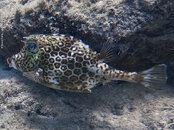HalcyonDaze
Contributor
Kind of funny under your hypothesis how a) they selectively barf up large reef fish instead of little things like burrfish and crabs, and b) the research data matches what spearfishers were reporting from cleaning their goliath kills back in the day.Hooked fish, which I would assume is how they were catching them, often empty gut contents, especially freshly swallowed prey, either by choice to fight and spit the baited hook, or due to swim bladder expansion pushing gut contents out. The latter is often noted on ascents even with speared fish. Remora and other species of fish often follow us up muching on the expelled gut contents.
A simple example pulled off the web.
View attachment 804458






